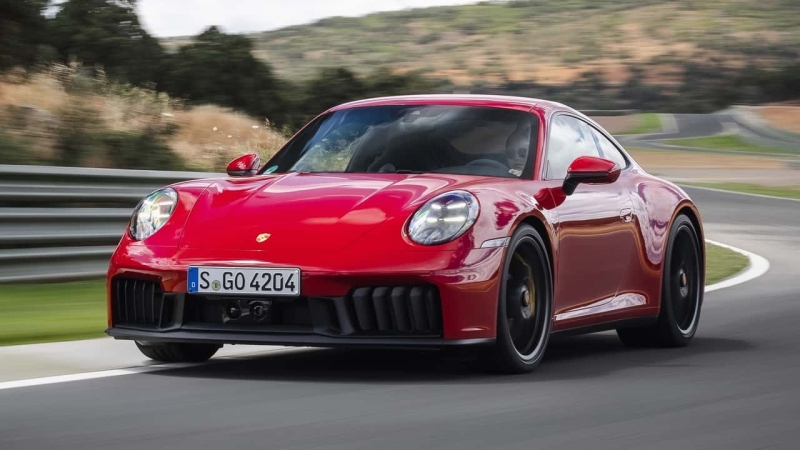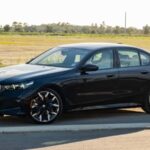Porsche engineers are very proud of its hybrid 911. They have every right to be.
Porsche
Porsche’s engineers insist the new 911 doesn’t feel like a hybrid. But how could it not? The new 911 Carrera GTS has an electric motor splined to the crankshaft of its flat-six, plus a massive electric turbocharger. It took me a little bit of time behind the wheel to figure out what they meant—Porsche’s new hybrid 911 does feel like a hybrid, just not like any hybrid before it.
Long rumored, Porsche debuted its new hybrid powertrain with the facelifted 2025 911 Carrera GTS. It uses a 1.9-kilowatt-hour, 400-volt lithium-ion battery pack under the front hood to power a 53.6-horsepower motor paired to a new 3.6-liter flat-six with an electric turbocharger. The turbo has a 14.7-hp motor situated on the shaft connecting the turbine and compressor wheels, which can accelerate or slow down the whole thing as needed. This means the turbo can limit boost pressure and put electrical energy back into the system. There’s no wastegate.
| Quick Specs | 2025 Porsche 911 Carrera GTS |
| Engine | Turbo 3.6-Liter Flat-Six Hybrid |
| Output | 532 Horsepower / 449 Pound-Feet |
| 0-60 MPH | 2.9 Seconds |
| Weight | 3,536 Pounds |
| Base Price / As Tested | $166,895 / $200,000+ |
It’s not a plug-in system like basically every other performance car from Europe at the moment, and there’s no clutch between the engine and the electric traction motor, so there’s no all-electric driving either. In total, you get 532 hp and 449 pound-feet of torque, which runs through an eight-speed PDK dual-clutch transmission to either the rear, or all four wheels.
The goal here was twofold. Design a system that was as light as possible—the target curb weight for the new GTS was just over 3,500 pounds, and US-spec cars weigh 103 pounds more than their predecessors—and one that allowed the engine to run at the ideal air-fuel ratio of 14.7:1 at all speeds to comply with stricter European regulations. And, of course, it had to offer a meaningful performance boost.
We headed to southern Spain to sample the new 992 in the Andalusian mountains and on the Ascari race circuit. At first, there are only subtle hints that the GTS is a hybrid. The engine fires in an instant, the traction motor taking over the duty of a traditional starter and its typical chuga-chuga-chuga-whump; and from low revs in a high gear, there is occasionally a sensation of instant torque that you don’t get in a non-hybrid 911. I spent the first few minutes trying to find the point where the car does something that makes you go, “Ah! That’s not normal!” Except for fleeting moments, it’s not there.
In reality, it’s exceedingly difficult to suss out what the system is doing because it’s almost constantly shuffling electric power between the traction motor, the turbo, and the battery. There’s a display on the infotainment screen illustrating power flow, though it’s almost impossible to follow with how quickly power moves around.
It’s endlessly fascinating, but it also feels normal. If you shut off the part of your brain trying to figure out what the hybrid system is doing, you just experience excellent throttle response, and, well, the sheer speed of it all. We started the day in a Carrera 4 GTS Cabriolet, and it hauls ass. There’s no big wallop of electric torque like you get in other performance hybrids, but smooth, prodigious, instant power delivery instead.
I can’t say it feels naturally aspirated, because the Carrera GTS is far too torquey. But it doesn’t feel turbocharged either because engine response is so good. It’s somewhere in between, and totally its own thing. The traction motor also does a lot at high engine speeds, coming in strong around 5,000 rpm to make the GTS’s flat-six wake up like a great naturally aspirated engine, compensating for the turbocharger as it starts to run out of puff.
What really gives the game away is the sound of the turbocharger. In Sport Plus mode, the car spools up the turbo more aggressively off throttle and under braking, and it makes all kinds of funky noises. Hit the brakes hard downshifting into a corner, and you can hear a whistle rising in pitch as the motor speeds up the turbo toward its 120,000-rpm maximum. Otherwise, it huffs and chuffs away as you get on and off throttle.
Chassis-wise, it feels very similar to the last Carrera GTS, which was the goal. Porsche widened the rear tires by 10 millimeters to 315 millimeters, the same size as the Turbo, and consequently changed some of the suspension components. The new engine is a bit narrower, which allowed Porsche to fit larger tires under narrower bodywork, and the extra power and torque demanded them. Porsche’s optional Dynamic Chassis Control (PDCC) active anti-roll bars now run off the 400-volt system, too, so they work more quickly and precisely.
Essentially, the 911 GTS stops and turns as brilliantly as ever. Even this all-wheel drive Cabriolet feels keen to dig into corners, and traction is typically 911 immense. There’s not a ton of suspension travel, yet the damping is superb. It’s a car you get keyed into straight away, inspiring the confidence to hustle it on a mountain road. Unlike a lot of hybrid cars, the 911 Carrera GTS uses a conventional braking system, where the pedal only directly connects to the brakes. But under braking, the traction motor does do some amount of regeneration, which you can’t really feel.
Driving on track has a wonderful way of focusing the mind. There’s not really time to think about how the hybrid system is working when concentrating on hitting your marks, especially on an unfamiliar circuit. Ascari is interesting, too, a long, narrow, technical track with basically one of every type of corner, and here, we benefit from following an instructor in a 911 Turbo S.
In a situation like this, you want a predictable car. Its outputs must match your inputs. Despite its complexity, the Carrera GTS is never underfoot. It does exactly what you want when you want it.
I spent the first few minutes trying to find the point where the car does something that makes you go, “Ah! That’s not normal!” Except for fleeting moments, it’s not there.
The hybrid system never crosses your mind here, which is a remarkable achievement. When you push the throttle pedal, it’s not simply sending a signal to the throttle body to open a certain amount. In an instant, the car has to make all kinds of decisions on how to use the engine and the hybrid components, and every time you go back to the throttle pedal—or come off it for that matter—the calculus changes. Yet, as a driver, you have no sense of this. You just get the torque when you want it.
Sure, the extra grunt of the system lets you use third gear to pull out of a chicane where you might have needed second otherwise, but there’s no penalty for revving it either. Just drive it as you would any other 911.
And as ever, the 992-generation 911 is a wonderful track car. Sweet handling balance, a talkative chassis, and mighty brakes inspire huge confidence, and the car feels like it’s ready to run all day. We sampled both rear-drive Carrera GTS and all-wheel drive Carrera 4 GTS, and frankly, it’s hard at times to tell the difference between the two.
Maybe the rear-drive version has slightly sweeter steering. But on turn-in and in mid-corner, the cars behave almost exactly the same. The all-wheel-drive system feels so subtle, the car obediently tucking the nose with a lift of the throttle, yet providing even better traction to pull the car straight at corner exit. Jorg Bergmeister, the Porsche factory driver who helped develop the new car, says the big differences between the two are only really evident when you’re far over the limit of grip.
All of the cars on hand for lapping had optional $9,780 carbon-ceramic brakes, which Porsche enlarged for the extra power. The front brakes and 10-piston(!) calipers are off the 911 Turbo, while the rears are unique to this car. In the great Porsche tradition, they are unflappable, stopping the car over and over again without a hint of fade and with seamless ABS engagement. Pedal feel is also superb, helping the driver meter out exactly how much pressure you need on initial application and as you bleed pressure off on turn-in.
On track, we also got a chance to sample the base, non-hybrid 992 Carrera for a few laps. It definitely feels lighter than the GTS, and yes, you obviously notice the relative lack of power. But, with 388 hp from a revised 3.0-liter twin-turbo flat-six, the Carrera is still plenty quick, and for a lot less money than the GTS, you get the vast majority of the 911 goodness. It’s a sweetheart.
The rest of the changes for this facelifted 992 are pretty minor. A digital gauge cluster brings more functionality, but it’s far less elegant than the analog tach of the previous model. The looks are subtly different, but integrating all the light functions into one unit helps clean up the front end. And there’s a push-button for starting the engine, which doesn’t have the same sense of occasion as a key. Things Porsche people may probably care about too much, but ultimately don’t matter.
A tougher pill to swallow is the price. Porsche is quick to point out the additional standard equipment and performance, but the Carrera GTS coupe starts at $166,895. Even the base Carrera, which isn’t all that different from last year’s model, rises in price by almost $8,000 to $122,095. And all of the GTS models we drove were specced beyond the $200,000 mark.
Really, this facelift is all about the hybrid. Porsche is rightfully proud of it. Its engineers are rightfully protective of the 911, and they feel like this is the best solution for the sports car. Porsche’s hybrid system is far lighter than any of its competitors’ systems, and it effectively meets the needs of increasing performance and response while dealing with more stringent regulations.
I still contend it feels like a hybrid because it feels different from the previous Carrera GTS. Yet, I get what the engineers are saying. This feels like the first truly no-compromise performance hybrid out there.
More importantly, it feels like a 911.
Competitors
- Chevrolet Corvette E-Ray
Get the best news, reviews, columns, and more delivered straight to your inbox, daily. Sign up For more information, read our
Privacy Policy and Terms of Use.
Gallery: 2025 Porsche 911 Carrera GTS Hybrid First Drive Review
Source: Porsche
2025 Porsche 911 Carrera GTS
Engine Turbocharged 3.6-Liter Flat-Six Hybrid
Motor Single Electric
Battery 1.9-Kilowatt-Hour Lithium Ion
Output 532 Horsepower / 449 Pound-Feet
Transmission Eight-Speed Dual-Clutch
Drive Type All-Wheel Drive
Speed 0-60 MPH 2.9 Seconds
Maximum speed 194 Miles Per Hour
Weight 3,536 Pounds
Efficiency TBD
Seating Capacity 4
Cargo Volume 4.8 Cubic Feet
Base Price $166,895
As-Tested Price $200,000+
On Sale Fall 2024



